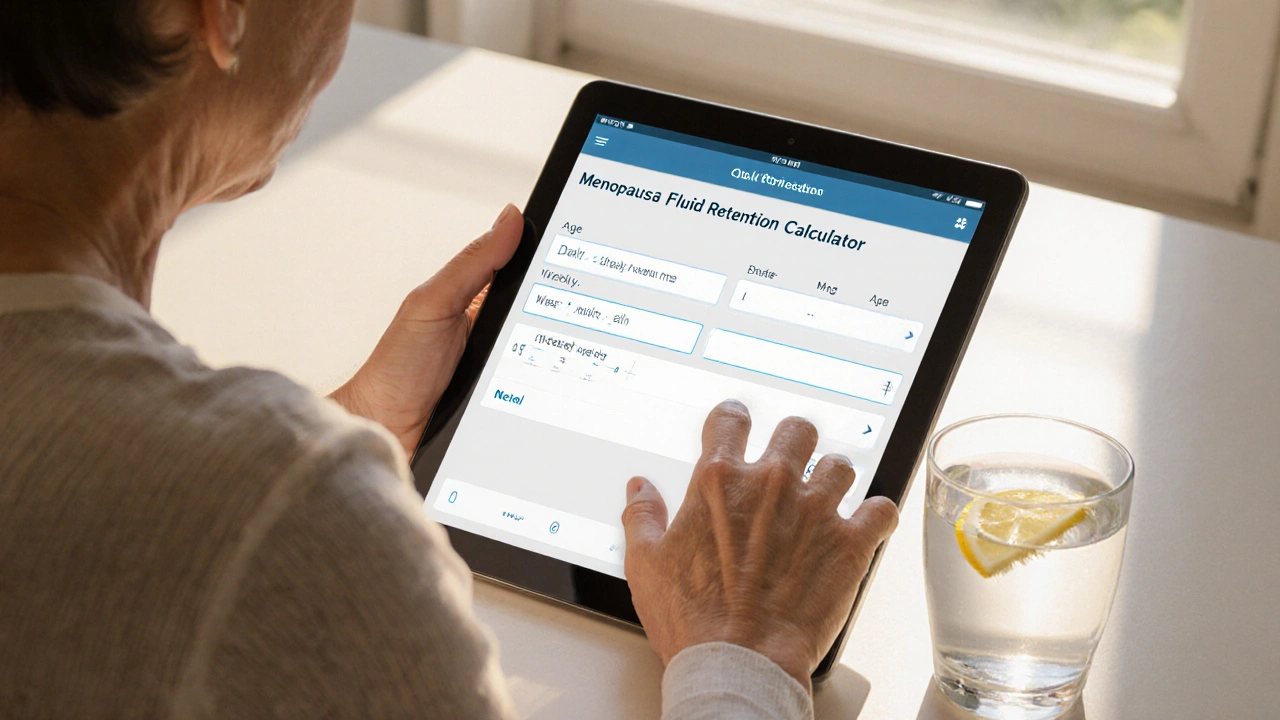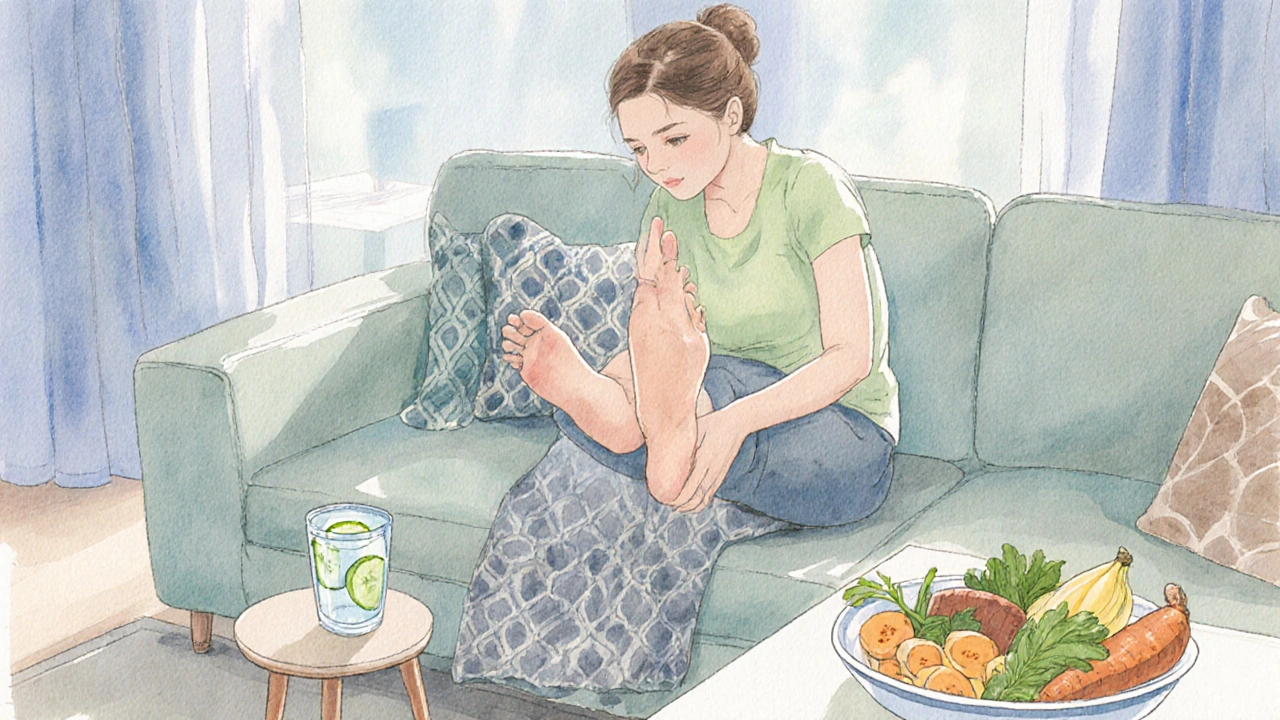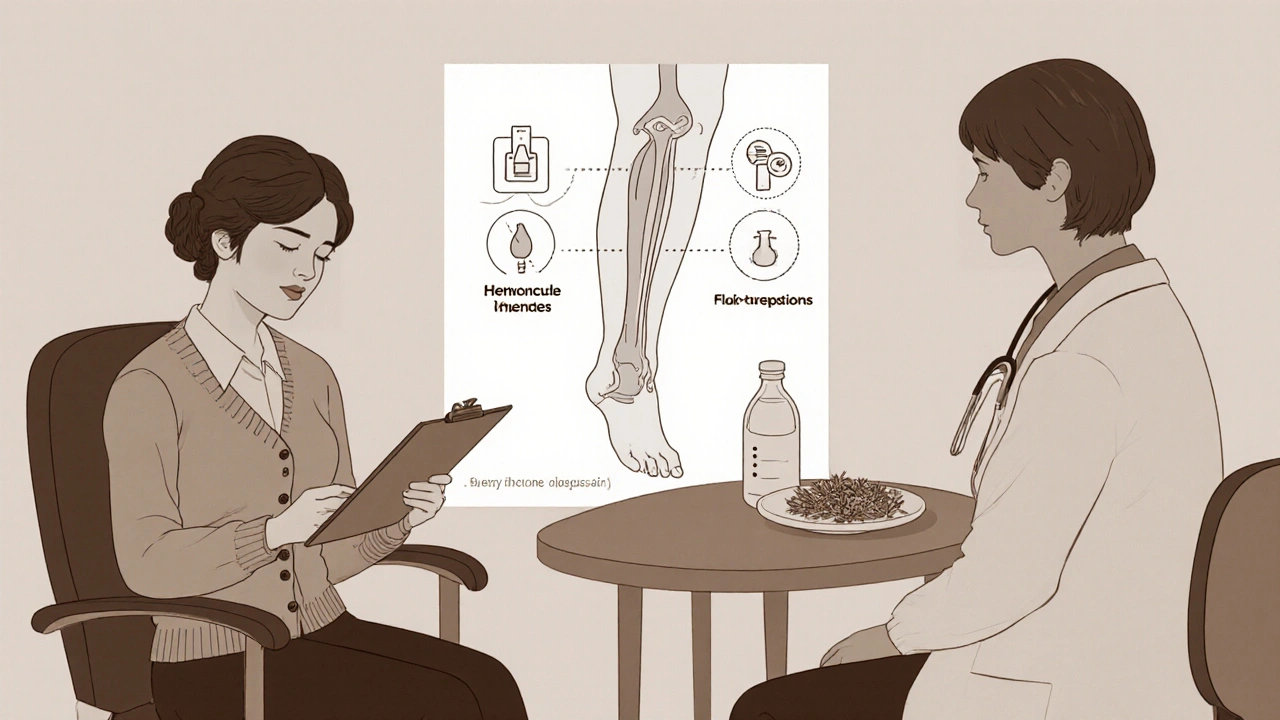 Oct, 3 2025
Oct, 3 2025
Menopause Fluid Retention Calculator
Enter your details and click "Calculate Risk Level" to see your fluid retention risk assessment.
Quick Takeaways
- Hormonal shifts in menopause can cause the body to hold extra water.
- Typical signs include bloating, swollen ankles, and a feeling of heaviness.
- Cutting back on sodium, staying active, and drinking enough water are the first line of defense.
- When lifestyle tweaks aren’t enough, low‑dose hormone therapy or diuretics may help.
- Regular check‑ups are key to rule out heart, kidney, or liver issues.
If you're spotting fluid retention during menopause, you’re not alone. Millions of women notice their bodies start to hold onto extra water as they transition into the later stages of their reproductive years. The good news? Most of the swelling can be managed with everyday choices, and a few medical options exist for the stubborn cases.
What Is Fluid Retention?
Fluid Retention is the buildup of excess fluid in the body’s tissues, medically known as edema. It most commonly appears in the lower legs, feet, hands, and abdomen. The condition occurs when the balance between fluid entering the bloodstream and fluid leaving it is disrupted, leading to a visible puffiness.
How Menopause Triggers Fluid Retention
Menopause marks the end of regular menstrual cycles, usually occurring between ages 45 and 55. During this transition, the ovaries produce less Estrogen, a hormone that helps regulate blood vessel tone and sodium balance.
Lower estrogen levels cause blood vessels to become slightly more permeable, allowing fluid to leak into surrounding tissue. At the same time, the body’s natural tendency to retain sodium increases, pulling even more water into the circulatory system. The combined effect is that many women experience noticeable swelling, especially after a long day on their feet.

Common Signs & When to Seek Help
- Swollen ankles or calves that feel tight in the morning.
- Bloating around the abdomen that doesn’t improve after a light walk.
- Weight gain of a few pounds over a short period, unrelated to diet.
- Feeling unusually heavy or “puffy” after a salty meal.
If the swelling comes with shortness of breath, chest pain, or sudden weight gain, call a doctor right away-those could be signs of heart or kidney problems that need immediate attention.
Lifestyle & Diet Strategies
Most women find relief by tweaking everyday habits. Here’s a practical checklist that you can start today:
- Watch sodium. Aim for less than 1,500mg per day. Processed foods, canned soups, and salty snacks are the usual culprits.
- Stay hydrated. Drinking 1.5-2liters of water helps the kidneys flush excess sodium.
- Tip: Add a slice of lemon or cucumber for flavor without extra salt.
- Move your legs. Light walking, ankle circles, or a short yoga flow can stimulate circulation.
- Even a 5‑minute calf raise routine three times a day makes a difference.
- Eat potassium‑rich foods. Bananas, sweet potatoes, and leafy greens help counteract sodium’s water‑holding effect.
- Elevate swollen limbs. Prop your feet on a pillow while you’re watching TV.
These steps target the two main drivers of menopause‑related edema: excess sodium and sluggish circulation.
Medical Options
When lifestyle changes don’t move the needle, a few medical approaches can be considered.
Hormone Replacement Therapy (HRT) supplies low doses of estrogen (and sometimes progesterone) to restore the hormone balance that helps keep blood vessels tight. Studies from the early 2020s show that short‑term HRT can reduce ankle swelling by up to 30% in symptomatic women, without a significant rise in cardiovascular risk when used at the lowest effective dose.
Diuretics are medications that increase urine output, helping the body shed excess fluid faster. They are typically prescribed for severe cases or when an underlying condition like hypertension is present. Common options include thiazide diuretics and potassium‑sparing agents.
Both HRT and diuretics require a prescription and regular monitoring, so discuss symptoms with your GP before starting any pill.
| Aspect | Lifestyle Changes | Medical Treatments |
|---|---|---|
| Effectiveness (average reduction in swelling) | 15‑30% | 30‑50% (depends on dosage) |
| Time to see results | 1‑2weeks | 3‑7days after starting medication |
| Potential side effects | Minimal (possible mild electrolyte shifts) | HRT: breast tenderness, mood changes; Diuretics: low potassium, dizziness |
| Cost (monthly, AU$) | ~30 (food, water) | ~70-120 (prescription and follow‑up) |
Quick Checklist Before Your Next Doctor Visit
- Document when swelling appears and how long it lasts.
- Track daily sodium intake for three days.
- Note any medicines you’re already taking (especially blood pressure pills).
- List lifestyle steps you’ve tried and the outcomes.
- Prepare questions about HRT dosage, duration, and monitoring.

Frequently Asked Questions
Why does my weight fluctuate during menopause?
Hormonal swings cause the kidneys to retain more sodium, which pulls water into the bloodstream. The extra fluid can add a few pounds, even if you haven’t changed your eating habits.
Can I use over‑the‑counter diuretics for menopausal swelling?
Most OTC options are herbal blends with mild caffeine. They might give a temporary lift, but they don’t address the hormonal root cause and can lead to dehydration. Talk to a GP before relying on them.
Is hormone therapy safe for managing fluid retention?
When prescribed at the lowest effective dose and used for a limited period, HRT is considered safe for most healthy women. It can improve vascular tone and reduce edema. However, a personal risk assessment is essential.
Should I avoid all salt during menopause?
No. Completely eliminating sodium can cause hyponatremia and affect muscle function. Aim for moderate intake (under 1,500mg per day) and choose natural sources like herbs, citrus, and vinegar for seasoning.
How much water should I drink each day?
About 1.5 to 2liters (6‑8 cups) for most women. If you exercise or live in a hot climate, you may need a bit more.

Jessie Eerens
October 3, 2025 AT 17:00When the tide of hormones ebbs, the vessel of flesh-our body-signals its disquiet; the swelling of ankles, the invisible weight of water, it is as if nature herself whispers a paradox, a reminder that equilibrium is a fleeting guest; we are urged, perhaps, to listen, to adjust our sodium intake, to gift our kidneys a gentler rhythm, to honor the quiet choreography of fluid and flesh.
Caroline Lane
October 3, 2025 AT 20:20I cant even begin to describe how much my body feels like a traitor during menopause, all that bloat and weight gain just drags you down like a heavy curtain and its honestly a moral failure of our society to ignore the pain of women dealing with this crap, we deserve better and i wont settle for empty advice!!
Geneva Lyra
October 3, 2025 AT 20:21Hey love, u r not alone in this, many of us have felt the same swelling and bloating, it's totally okay to ask for support, maybe try adding some gentle yoga or a short walk each day, and remember to drink water even if it feels counterintuitive-our bodies are more resilient than we think :)
Moritz Bender
October 3, 2025 AT 22:33From a clinical perspective, fluid retention in peri‑menopause often correlates with altered natriuresis and decreased aldosterone clearance; reducing dietary sodium below 1500 mg/day, increasing intake of potassium‑rich foods, and integrating aerobic activity ≥30 min can enhance renal excretion-hope this helps! 😊
Nicole Hernandez
October 3, 2025 AT 23:56It’s encouraging to see that small lifestyle tweaks can make a big difference; staying hydrated, opting for balanced electrolytes, and moving a bit each day not only alleviates puffiness but also lifts mood-keep experimenting and celebrate each improvement, you’re doing great.
florence tobiag
October 3, 2025 AT 23:58But have you considered that the whole "hydrate more" narrative is a smokescreen, deliberately crafted by the beverage industry to keep us dependent on sugary drinks; the real culprit might be hidden fluoride in our water supply, subtly sabotaging renal function-stay vigilant!
Terry Washington
October 4, 2025 AT 01:20Let us be perfectly clear: the complacent acceptance of fluid retention as an inevitable part of menopause is a disgraceful abdication of personal responsibility; one must wield the sword of discipline-cut out processed salts, demand rigorous exercise, and reject any notion of passive suffering.
Claire Smith
October 4, 2025 AT 02:43Honestly, this is just another health fad.
Émilie Maurice
October 4, 2025 AT 02:45The statement above is not only inaccurate but also displays a lack of basic understanding; menopause-related edema is a documented physiological response, and dismissing it as a "fad" undermines scientific evidence.
Roxanne Lemire
October 4, 2025 AT 04:06Fluid balance is a subtle dance that our bodies perform without fanfare. Over the years I have watched many women grapple with the quiet swell of ankles and the stubborn weight that seems to appear overnight. It is not magic nor a curse but a physiological response to hormonal shifts. The kidneys, tuned by estrogen, begin to retain sodium, and with it water follows. A modest reduction in processed salt can tip the scales back toward equilibrium. Likewise, consistent movement-walking, gentle cycling-promotes circulation and encourages the excess fluid to return to the bloodstream where it can be filtered out. Hydration, paradoxically, is also key; sipping water throughout the day signals the body that it does not need to hoard. Even the posture you adopt while sitting can affect lymphatic drainage, so consider raising your legs occasionally. Nutrition plays its part; foods rich in potassium like bananas and leafy greens help counteract sodium. Stress, too, raises cortisol, which can exacerbate retention, so finding moments of calm benefits the whole system. Often, the feeling of heaviness is as much mental as physical, a reminder that our perception shapes experience. In short, small, consistent habits over weeks can produce noticeable relief without the need for drastic measures. Remember, each body tells its own story, and listening is the first step to healing.